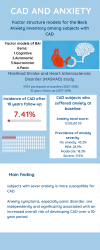Anxiety, a significant risk factor for coronary artery disease: what is the best index
- PMID: 38877499
- PMCID: PMC11177367
- DOI: 10.1186/s12888-024-05798-w
Anxiety, a significant risk factor for coronary artery disease: what is the best index
Abstract
Background: Coronary artery disease (CAD) is known as the leading cause of disability and death globally. Anxiety disorders are also recognized as common types of mental disorders that substantially impact global health. Iran ranks among the countries with a high incidence of CAD and anxiety disorders. Therefore, the present study aims to determine the potential association and epidemiological aspects of anxiety and CAD within the population of Mashhad, the second most popoulos city in Iran.
Methods: The present study is based on extracted data from the Mashhad stroke and heart atherosclerotic disorder (MASHAD) study which is a 10-year prospective cohort study intended to assess the effects of various CAD risk factors among Mashhad city residents. Anxiety scores were assessed at the baseline using Beck Anxiety Inventory and individuals were classified based on the BAI 4-factor structure model which included autonomic, cognitive, panic, and neuromotor components. Accordingly, the association between baseline anxiety scores and the BAI four-factor model with the risk of CAD events was analyzed using SPSS software version 21.
Results: Based on the results, 60.4% of the sample were female, and 5.6% were classified as having severe forms of anxiety. Moreover, severe anxiety was more prevalent in females. Results showed a 1.7% risk of CAD (p-value < 0.001) over 10 years with one unit increase in anxiety score. Based on the 4-factor model structure, we found that only panic disorder could significantly increase the risk of CAD by 1.1% over the 10-year follow-up (p-value < 0.001).
Conclusion: Anxiety symptoms, particularly panic disorder, are independently and significantly associated with an increased overall risk of developing CAD over a 10-year period. Therefore, further studies are warranted to investigate the mechanisms through which anxiety may cause CAD, as well as possible interventions to mitigate these processes.
Keywords: Anxiety; Beck anxiety inventory; Coronary artery diseases; Factor structure model; Panic disorder.
© 2024. The Author(s).
Conflict of interest statement
The Authors declare that there is no conflict of interest.
Figures




References
-
- Roth GA, Mensah GA, Johnson CO, Addolorato G, Ammirati E, Baddour LM, Barengo NC, Beaton AZ, Benjamin EJ, Benziger CP, et al. Global Burden of Cardiovascular diseases and Risk factors, 1990–2019: Update from the GBD 2019 study. J Am Coll Cardiol. 2020;76(25):2982–3021. doi: 10.1016/j.jacc.2020.11.010. - DOI - PMC - PubMed
-
- Global regional. National disability-adjusted life-years (DALYs) for 359 diseases and injuries and healthy life expectancy (HALE) for 195 countries and territories, 1990–2017: a systematic analysis for the global burden of Disease Study 2017. Lancet. 2018;392(10159):1859–922. doi: 10.1016/S0140-6736(18)32335-3. - DOI - PMC - PubMed
-
- Sarrafzadegan N, Mohammmadifard N. Cardiovascular Disease in Iran in the last 40 years: Prevalence, Mortality, Morbidity, challenges and Strategies for Cardiovascular Prevention. Arch Iran Med. 2019;22(4):204–10. - PubMed
Publication types
MeSH terms
Grants and funding
LinkOut - more resources
Full Text Sources
Medical
Miscellaneous

